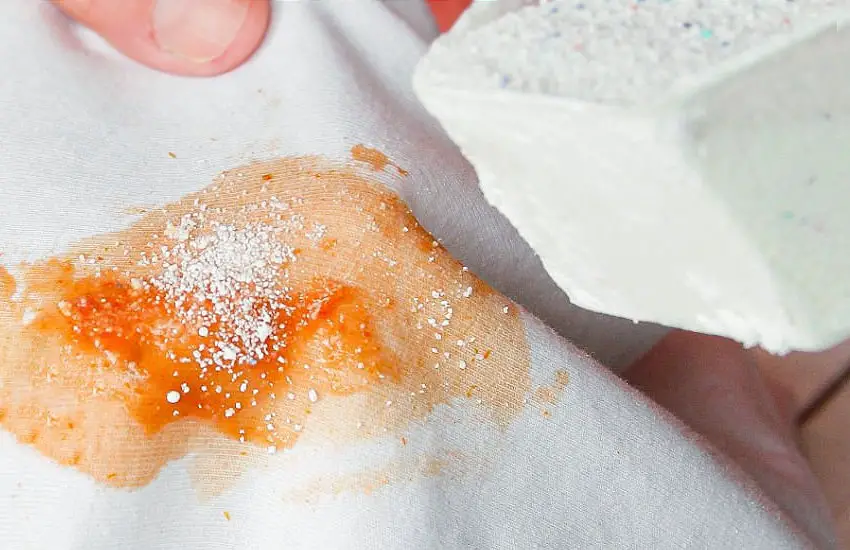As an Amazon Associate, I earn from qualifying purchases at no extra cost to you.
How to Easily Remove Transmission Fluid from Clothes
During your time working on cars, you might accidentally get transmission fluid on your clothes. It can be a real mess and tough to clean. But don't worry! In this article, we will show you how to remove transmission fluid from clothes in a simple and easy way.
You don't need any fancy tools or special skills. Just a few common items from around your home can help get your clothes looking fresh again. Let's dive into some quick tips and tricks that will make cleaning up that nasty spill a breeze. Your clothes will thank you!
How to Remove Transmission Fluid Stains from Clothes
With the right steps and materials, you can clean the stain and make your clothes look good again. This guide will help you understand how to get rid of those annoying stains. Follow these easy steps, and you will be able to save your clothes without much trouble.

What You Will Need
Before you start cleaning, gather all the materials you need. Having everything ready makes the cleaning process easier. Here is a list of items you will need:
- Paper towels or clean cloth: These will help you blot the stain.
- Dish soap: A grease-fighting dish soap works best for breaking down oily stains.
- Baking soda or cornstarch (optional): These can help absorb extra oil from the stain.
- Old toothbrush or soft brush: This is used to gently scrub the stain.
- Warm water: You will need this for rinsing and washing the clothes.
- Laundry detergent: This will help remove any remaining stain after you wash the clothes.
Step 1: Blotting the Stain
When you notice a transmission fluid stain, act quickly. The first thing to do is to blot the stain. Take a paper towel or a clean cloth and gently press it against the stain. You want to soak up as much fluid as possible. Be careful not to rub the stain because this can spread it to a larger area. Just press down lightly and lift the towel away. If the paper towel gets dirty, use a clean part or a new towel to continue blotting. Repeat this step until you can't see any more liquid coming off.
Step 2: Applying Baking Soda or Cornstarch
After blotting, you can use baking soda or cornstarch to help absorb more of the oil. Sprinkle a small amount of baking soda or cornstarch over the stain. Let it sit for about 15 minutes. This will help soak up the remaining oil from the fabric. After 15 minutes, use an old toothbrush or a soft brush to gently brush off the baking soda or cornstarch. You should see that some of the oil has been absorbed. If you can still see the stain, don't worry! You can continue cleaning it.
Step 3: Using Dish Soap
Now it's time to use dish soap. Take a small amount of dish soap and put it directly on the stain. Dish soap is great for breaking down greasy stains like transmission fluid. Use your fingers or the old toothbrush to work the soap into the stain. Gently rub the fabric together to help the soap get into the fibers. Be careful not to scrub too hard, as this can damage the fabric. Let the dish soap sit on the stain for about 10 to 15 minutes. This will give it time to break down the grease.
Step 4: Rinsing with Warm Water
After letting the dish soap sit, it's time to rinse the stain. Take the fabric to a sink or use a bowl of warm water. Rinse the stained area with warm water to remove the dish soap and the loosened stain. Make sure to rinse thoroughly to get rid of all the soap. If the stain is still there, you can repeat the dish soap step. Don't be afraid to go over the stain a few times if it needs more cleaning. Rinsing with warm water is important because it helps lift the stain from the fabric.
Step 5: Washing with Laundry Detergent
Once you have rinsed out the dish soap and most of the stain, it's time to wash the clothes. Put the item in your washing machine. Use your regular laundry detergent and wash the clothes according to the care label instructions. Be sure to check the label for the best water temperature and washing method. If your clothes are safe to wash in warm water, it can help remove any remaining stains. If you are unsure, cold water is usually a safe choice for delicate fabrics.
Step 6: Checking Before Drying
After the wash, it is important to check the stain before you dry the clothes. If the stain is still visible, do not put the item in the dryer. The heat from the dryer can set the stain, making it harder to remove. If the stain remains, repeat the steps of applying dish soap and washing again. You can also consider using a stain remover spray or gel if you have one. Always read the instructions on the product before using it. After you are sure the stain is gone, you can dry your clothes as usual.
Removing transmission fluid stains from clothes is not as hard as it may seem. With the right materials and steps, you can clean your clothes effectively. Always remember to act fast when you spill fluid, as this can help prevent the stain from setting in.
Alternative Methods
1. Using Rubbing Alcohol
- Blot the stain: Start by blotting the stain with a paper towel to remove as much fluid as possible.
- Apply rubbing alcohol: Soak a clean cloth or cotton ball in rubbing alcohol and dab it on the stain. Work from the outside of the stain towards the center to avoid spreading it.
- Blot again: Use a clean paper towel to blot the area after applying alcohol.
- Wash: Rinse with warm water and wash as usual.
2. Using Vinegar and Dish Soap
- Mix a solution: Combine one cup of white vinegar and two tablespoons of dish soap in a bowl.
- Apply the solution: Use a sponge or cloth to apply the mixture directly to the stain. Gently scrub with a soft brush if needed.
- Rinse and wash: Let it sit for 10-15 minutes, then rinse with warm water and wash as usual.
3. Using Commercial Stain Removers
- Choose a stain remover: Pick a commercial stain remover that's effective on grease stains.
- Follow instructions: Apply the stain remover directly to the stained area according to the product instructions.
- Wash: Let it sit for the recommended time, then wash the item as usual.
4. Using Baby Powder or Talcum Powder
- Sprinkle powder: If the stain is fresh, sprinkle baby powder or talcum powder on the stain. This helps absorb the oil.
- Let it sit: Allow the powder to sit for about 30 minutes.
- Brush off: Gently brush off the powder, then treat the area with dish soap or rubbing alcohol before washing.
5. Using WD-40 (for Tough Stains)
- Spray on stain: Lightly spray the stained area with WD-40.
- Let it sit: Allow it to sit for about 10-15 minutes.
- Blot and wash: Blot the area with a paper towel, then wash the item as usual. Be sure to wash it separately, as WD-40 can leave a residue.
6. Using Lestoil or Pine-Sol
- Apply the cleaner: Apply a small amount of Lestoil or Pine-Sol directly onto the stain.
- Let it sit: Allow it to sit for about 10-15 minutes.
- Wash: Rinse with warm water and then wash the item in your washing machine.
Tips for Success
- Test first: Always test any cleaning solution on a small, hidden area of the fabric first to ensure it doesn't cause damage or discoloration.
- Follow care labels: Make sure to follow the care instructions on the clothing label to avoid damaging the fabric.
- Act quickly: The sooner you treat the stain, the better your chances of completely removing it.
By trying one of these alternative methods, you may be able to effectively remove transmission fluid stains from your clothes.
Are These Questions in Your Mind?
Is it safe to use rubbing alcohol on all fabrics?
Using rubbing alcohol is generally safe on most fabrics, but it is always best to test it on a hidden area first to avoid damage or discoloration.
Can I use hot water to remove transmission fluid stains?
Hot water can help break down grease and oil stains, but always check the care label of your fabric first to see if hot water is safe for that material.
Do I need to pre-treat the stain before washing?
Yes, pre-treating the stain with a cleaning solution or stain remover can help lift the stain before washing, leading to better results.
Is it necessary to use a soft brush when cleaning?
Using a soft brush can be helpful for gently working cleaning solutions into the fabric, but it is not strictly necessary. You can also use your fingers or a cloth.
Can baking soda be left on the stain overnight?
Yes, you can leave baking soda on the stain overnight to absorb more oil. Just be sure to brush it off gently before treating the stain further.
Do I need to wash the stained item separately?
It is a good idea to wash the stained item separately from other clothes to prevent any possible transfer of the stain to other fabrics.
Is it okay to dry the stained item in the dryer?
No, it is not okay to dry the stained item in the dryer until you are sure the stain is completely gone. Heat can set the stain and make it harder to remove.
Can I use dish soap on delicate fabrics?
While dish soap is effective for removing grease, it may not be suitable for all delicate fabrics. Always check the care label and consider using a gentle soap instead.
Is it possible to remove old stains?
Yes, it is possible to remove old stains, but it may require more effort and multiple treatments. Be patient and persistent.
Do I have to use commercial stain removers, or can I make my own?
You don't have to use commercial stain removers; many homemade solutions can effectively remove stains. Common household items like vinegar and baking soda can be effective alternatives.











